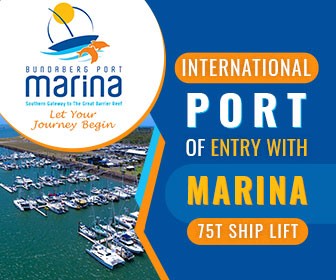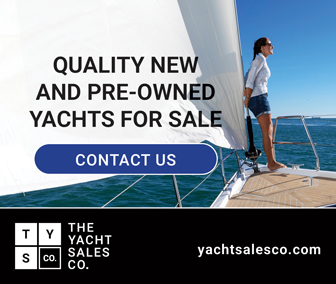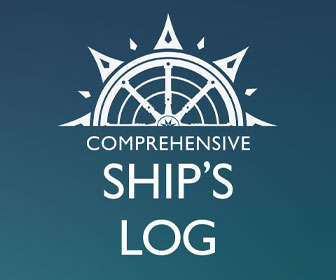Portrait of a Cruiser: Wayne and Alison Sollars of S.Y. Blue Heeler
Australians Wayne and Alison Sollars decided thirteen years ago that their lives would be more fulfilled if they bought a boat and sailed off into the blue yonder. With no knowledge of boats and sailing, they made a five-year plan to save and learn before casting off their lines and departing Australian shores in 2011. Eight years later they made it to northern Europe, spending last winter in Flensburg Germany, and this winter in Whitehaven, UK. This cruising couple have no particular plan other than to simply explore the world and enjoy the outdoor life.
Published 4 years ago

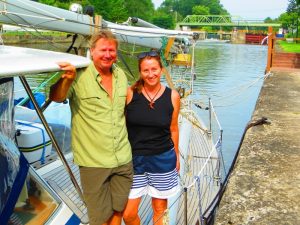
- Wayne and Alison on Blue Heeler when they tackled the Great Loop in 2015. Photo taken at Lyons, New York along the Erie Canal to the Great Lakes.
Names of Owners: Wayne Sollars and Alison Sollars
Nationality: Australian
Boat Name: Blue Heeler
Boat Type/Model and Size: Hallberg Rassy HR39, 12m
Home Port: Melbourne, Australia
Blog/website/facebook pages:
- Blog: www.BlueHeelerHR39.com
- Facebook: www.facebook.com/Blueheelerhr39/
- Twitter: @BlueHeelerHR39
How did you start cruising?
Over the years, both of us enjoyed traveling and getting away on weekends for kayaking, rock climbing, and other outdoor adventures. In the mid 2000s we had good jobs, but little time to enjoy life; at least the type of life we wanted to live. Why not sell the house, buy a boat and travel the world? It sounds easy now, but there’s plenty to consider – first we had to learn how to sail!
We gave ourselves five years to get it together.
Describe what sort of cruisers you are:
We are fulltime live-aboard cruisers. Blue Heeler has been our home since January 2011. Every couple of years we may return to Australia to visit family and friends, or take a trip overland for a few weeks, but we always return to Blue Heeler.

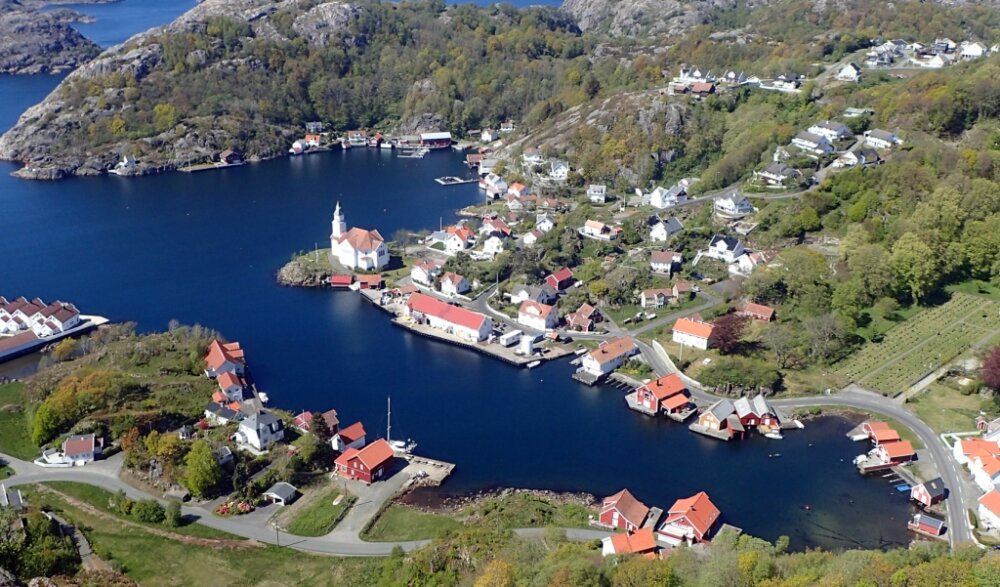
- 2019 Kirkehavn, Norway – Blue Heeler the only yacht in the small harbor
What type of cruising are you doing currently?
Presently we are coastal sailing around Northern Europe. We’re not in a hurry and sail wherever the seasons take us. A circumnavigation is not the ultimate goal as we plan to visit many countries around the world and have the freedom to go wherever our mood takes us. For example, in 2016 we sailed from the Caribbean to Bermuda and New York so we could go through the Erie Canal to the Great Lakes and down the inland waterways to Alabama – an amazing journey for a twelve-meter sloop! In 2018 we sailed up to Estonia and Finland then through the Swedish Archipelago and eventually up to Norway.

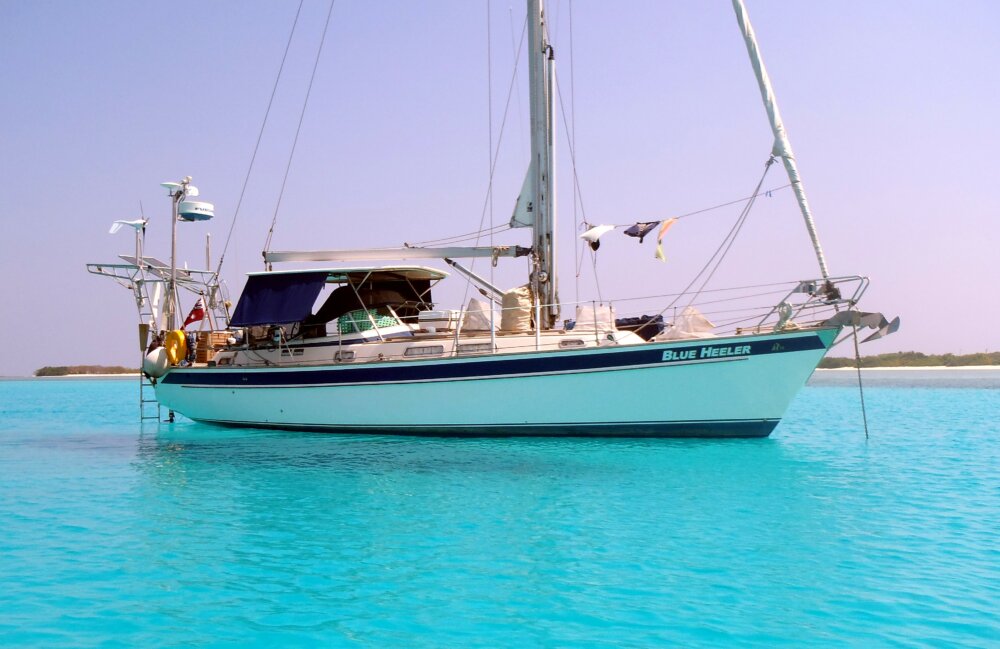
- 2014 – Beautiful blue anchorages within the Maldives while crossing the Indian Ocean
What were the key reasons you selected your current boat?
Back in 2005 once the seed was planted to ‘sell the house and go sailing’, we began researching the type of boat people would buy, particularly a boat for those who had never sailed! One condition was to buy a sturdy blue-water boat that didn’t need too much work – the last thing we wanted was a ‘project’. After considering our options, we focused on a Hallberg Rassy, which came up time after time as a quality, solid blue water cruising yacht.
So what size boat? Of course budget plays a part in this decision, so we decided on a HR39 which seemed big enough to cross oceans, small enough to handle and matched our budget. Fortunately for us, a boat was for sale in New Caledonia in 2008 and in excellent condition so we snapped it up and brought it back to Australia to prepare for our new lifestyle.
What other boats have you owned?
As avid water skiers and scuba divers we had a 5m runabout plus sea-kayaks, but this is the only yacht we’ve owned. I can’t imagine living on another yacht.

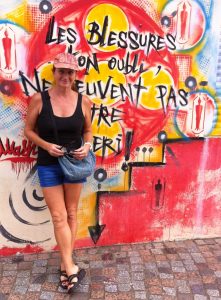
- 2016 enjoying the sights of Martinique, Caribbean
What changes have you made to your current boat?
Where do I start?
- The boat was constructed in 1996/97, so many of the gadgets from that era have since been replaced with modern technology. We threw out the paper charts and installed a chart plotter, AIS and satellite phone, plus upgraded the VHF and radar.
- In 2013 in Thailand, we replaced the teak deck and had a davit built at the stern for solar panels.
- Blue Heeler is always having either regular maintenance or changes made to suit our long term liveaboard lifestyle.
- The most noticeable change to the profile of Blue Heeler is the addition of a hard top. Complimented with Sunbrella curtains this makes an enclosed area that is fantastic for sailing and living in colder, wetter climates like Norway or the UK. It also keeps the hot sun from frying our skin; a definite bonus in the tropics.
- This year we’ve replaced the old engine with a new engine so we plan to have many more years of cruising aboard Blue Heeler.
Most useful equipment fitted, and reasons for this choice:
I just threw this question to Skipper and we both agree an iPad has to be the most versatile piece of equipment we have on board. Of course when we left in 2011, iPads were just coming onto the market. But now, the iPad is used for navigation, weather information downloaded from a Satphone, contacting family, researching, and many other useful and fun applications.
As far as the boat goes, we consider everything has its usefulness – from the sails, three-burner stove, the solar panels, the wind-pilot, to the toilet and the bow-thruster. Blue Heeler is the sum of its parts.
Equipment regrets, or things you would do differently:
In 2015 we invested in a Raymarine ‘touchscreen’ a128 Multi-function Device. By July 2019 this unit had a fault so we sent it off for repair. Bad news was that it couldn’t be repaired and as all our other peripheral gadgets are Raymarine, we were forced to buy a new chart plotter less than four years after the initial purchase and only nine months after the extended warranty expired. This is a costly exercise and highly disappointing, and certainly an inconvenience.
I think the best approach to cruising on a budget is to ‘keep it simple’.

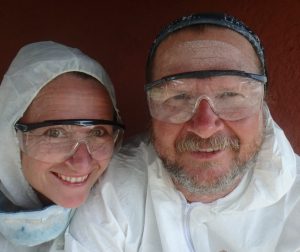
- 2016 – Working together is part of cruising life – Trinidad
What are the questions you are asked the most?
The most common question we are asked is “How long have you been sailing?”, followed quickly by an incredulous “You’ve lived together all that time and you’re still together?!”. That always makes us laugh.
Another popular question is “Why the boat name, Blue Heeler?”. A Blue Heeler is an Australian Cattle Dog, and we had a blue heeler dog named Spud. He passed away while Wayne was bringing the boat from New Caledonia after we purchased it. So as the original name of the boat had no meaning to us, we dedicated the boat to our hairy mate.
A bluewater boat that heels over – of course, had to be called “Blue Heeler”.
List the countries you have cruised:
Australia, Indonesia, Malaysia, Thailand, Sri Lanka, Maldives, Chagos, Rodrigues, Mauritius, Reunion, Madagascar, South Africa, Namibia, St Helena, The Caribbean – Lesser and Greater Antilles including Cuba and Puerto Rico, Trinidad, Bermuda, USA (Inland Waterways), UK, Azores, France, Germany, The Netherlands, Latvia, Estonia, Finland, Sweden, Norway, Isles of Scotland including Shetland and Orkney, and the UK.
Future cruising plans:
Our plans, like most sailors, are written in the sand, and could easily be washed away at any time. But for now, we plan to slowly make our way back to Australia, via the Mediterranean first, then across the Atlantic, and across the Pacific. Who knows how long this will take us; already we’ve taken nine years so it could be a while until we return. Then we have the coastline of Australia to do…

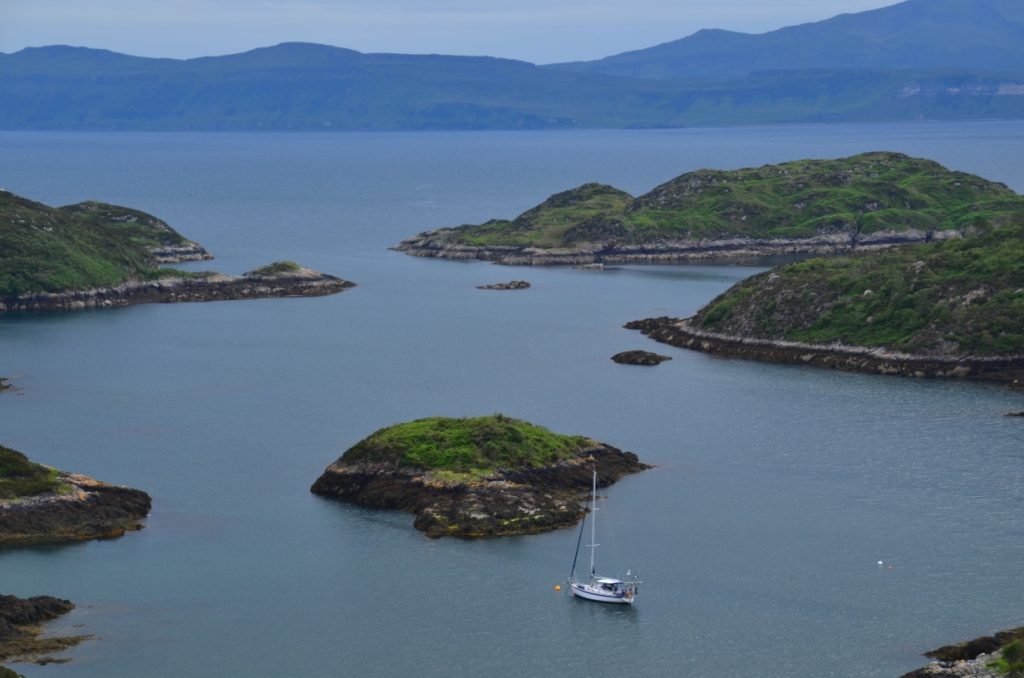
- 2019 Summer sailing in Scotland with views to Skye.
List the oceans/seas you have crossed:
Bass Strait; Arafura Sea; Timor Sea; Java Sea; Bay of Bengal; Indian Ocean, South Atlantic; Caribbean Sea; Gulf of Mexico; North Atlantic (twice – once from the Caribbean to New York; then Caribbean to Azores/UK); Baltic Sea; North Sea. I may have left out some, and the Pacific is still on the to-do list!
Approximate sea miles:
By our estimation around 45,000nm in the eleven years we’ve owned Blue Heeler. That’s at least twice the circumference of the earth!

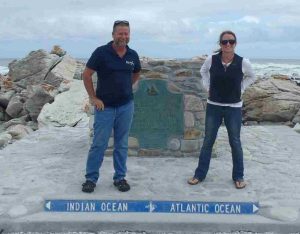
- 2014 – Straddling the marker of the Indian Ocean and the Atlantic Ocean after rounding the Cape of Good Hope, South Africa
Scariest day on the water:
Crossing the South Atlantic on our way sailing from St Helena to the north coast of Brazil, about 1,000nm from land, Blue Heeler hit ‘something’. At first we had no idea what it could have been and I rushed to the stern but couldn’t see anything except a darkish mass under the water. Wayne spent the rest of the day checking the hull for leaks and even jumped overboard to see if we had any keel/rudder damage, but thankfully no damage. As far as we know from the sound of the thud, we believe we must have hit a sleeping whale. It was scary, but we were so relieved the bilge pump didn’t activate!
Best cruising moment:
The best cruising moments for me are out on the ocean, preferably on a moonlit night, watching the bright phosphorescence as we glide along. Similarly, the morning sunrise can be breathtakingly stunning, given the right conditions. The South Atlantic was the best long-distance sail with constant wind and fair weather. For Skipper, the best moments are those when he doesn’t have to fix something!

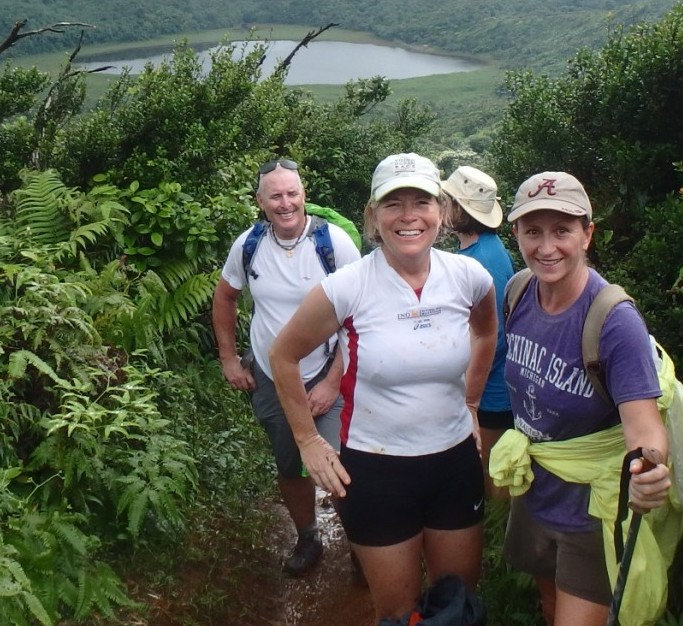
- 2016 – Hiking with friends in Grenada, Caribbean
Favorite cruising area and why:
The Caribbean has to be my favorite, so far of course, as we haven’t sailed the Mediterranean or the Pacific. The Baltic and Scottish islands are also wonderfully scenic sailing grounds, although they lose points for being so cold! In the warmer zones jumping in the water for a swim at any time is pure bliss, and the ability to sail from island to island in a day, changing countries along the way is fun.
We spent three months from November to January hanging out on anchor in Fort de France, Martinique and joined in the New Year’s Eve fireworks celebrations of 2016. The downside is that the Caribbean is so far from Australia and can be overcrowded at times.
My next favorite cruising area has to be the coastline of Australia. Although rugged and remote, the sailing can be perfect (but just as nasty), as long as you’re following the trade winds.
Favorite anchorage:
The best anchorage by far has to be Lizard Island, Queensland.
For a month we stayed on the hook in 2011 and also in 2012 and enjoyed excellent diving, swimming, and walking. Mind you, since that time the island was destroyed by a cyclone. Nonetheless, I have wonderful memories of swimming from the boat to the huge clam field, walks up Cook’s Look, and having a few drinks and jam sessions at the small cruisers bar with crews from the few boats that inhabit the anchorage during the winter season.
The second favorite would have to be Chagos in the middle of the Indian Ocean. We stayed there one month in 2014 and for an entire week, we were the only couple there! To be so secluded on a remote island in the middle of an ocean is such an incredible feeling.

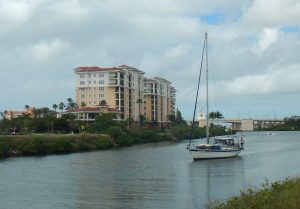
- 2015 – Traveling along the ICW on the west coast of Florida
Favorite cruising apps:
Okay, here’s the list of my favorite apps when cruising:
- iNavX, Navionics for charts/routes
- Iridium Mail & Web (for Satphone)
- Weather4D for displaying grib files (each country typically has their own weather sites so we usually download the local weather as well); we also refer to Windy which is a good visual weather app.
- AyeTides for tidal information (we also refer to other sources and never use just one source).
- Google Earth is always handy, as is Google Translate.
- Of course, social apps such as Facebook, FaceTime and Skype help you stay in touch with loved ones – a luxury I guess, and something that past sailors probably wished they had.
- For those lonely night watches, listening to Podcasts and playing Scrabble are high on the list.
Favorite cruising websites:
Over the years we’ve learned a lot from many websites, and Noonsite has always been our first go-to website for local information, but also, other sailor blogs are a good reference and have helped us along the way. I write my blog in the same manner, hoping the information I put out is useful to anyone interested in sailing specific routes. Active-Captain is also a good reference for anchorages. There are plenty of Facebook pages now for various sailing groups so they are also a good go-to for sharing information.

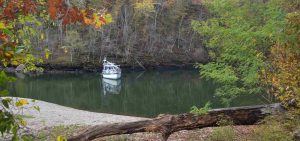
- 2015 – ICW, Pickwick Lake, Tennessee
Favorite cruising books:
In the five years we were preparing to go cruising we read heaps of books; many cruising stories written by live-aboard sailors but also factual accounts such as Joshua Slocum’s ‘Sailing Alone Around the World’. I always got a laugh from Fatty Goodlander’s stories too. In 2007 I bought the Jimmy Cornell ‘World Cruising Routes’ which we refer to when planning ocean passages. Hard copy pilot books are easy to flick through and we buy those in preference to electronic pilots when we can.
What advice or message would you want to pass on to anyone new to cruising or thinking about casting off the dock lines?
Before we sailed away we intentionally gave ourselves five years to work hard, plan, save and buy a boat. In 2005, neither of us had sailed so we had a steep learning curve. We had traveled and were avid campers, scuba divers and rock-climbers. Also, we were used to living in small places on a budget – the transition to living on a boat was quite easy. It was everything else that had to be considered.
To anyone thinking about going cruising:
- Read everything to do with cruising and sailing.
- Become comfortable with your chosen future lifestyle, and keep planning realistically.
- Set a goal – where do you want to go?
- How long do you want to be away?
- You may not see your family for months, will that be a problem?
- How capable or resourceful are the crew to fix things?
- Will you sell everything including the house? Funding the lifestyle is a big consideration – should you save then spend all your money or invest and live frugally?
- Oh, and learn how to sail! Join a local sailing club, and do a RYA sailing course or two.
Depending on your budget you may have to forego the luxuries of land-life. You will probably be on a fixed budget – the boat will take up most of that. You don’t need ‘stuff’ anymore and you’ll be surprised just how little you need to enjoy life.

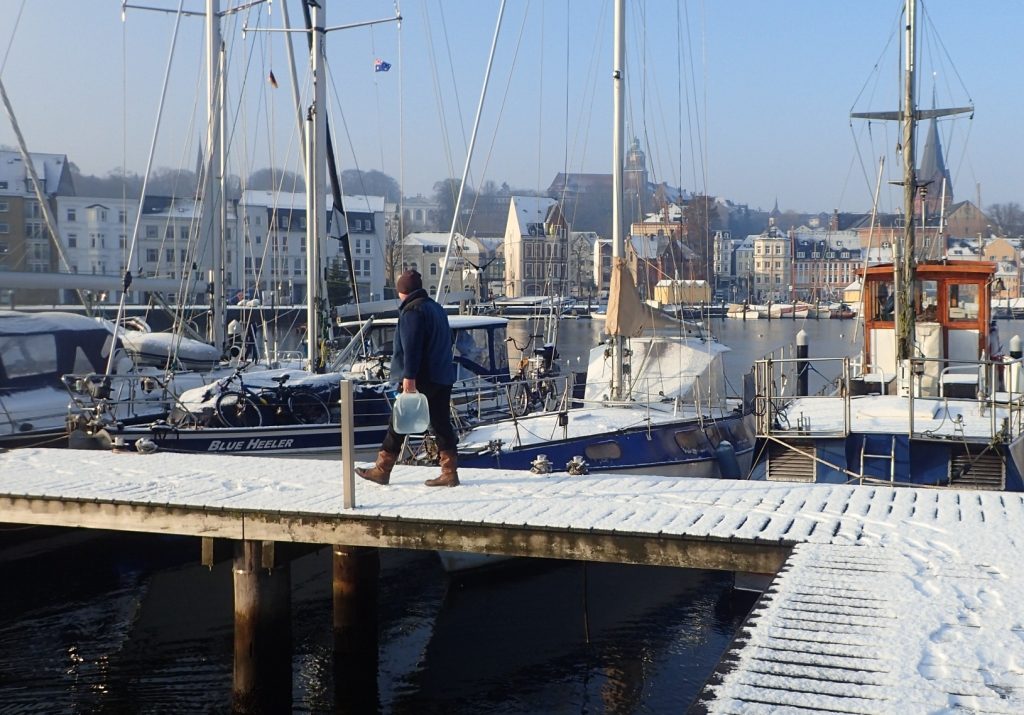
- 2018 – Flensburg Germany, water is turned off so we have to lug water through the snow
Sailing is a small percentage of your life as a cruiser. The rest of your time will be spent learning a language, sewing, researching, passage planning, repairing, rewiring or renovating – grocery shopping can take hours, as can sitting in a laundromat so be sure you have plenty of podcasts and e-books!
At the moment we are high and dry living in a boatyard as we are replacing our engine, replacing our skin-fittings and installing new plumbing and toilet. It’s not all Pinot and fromage!
I guess the biggest thing to consider is whether you really want to step away from your existsing life on land. However, you won’t know that until you’re actually cruising. Once you cut off the ties to land, you may find yourself crying “What have I done!”. Only time will tell if you’ve made the right decision. After eight years living aboard, I can’t imagine returning to a life on land, at least not for now.
Why cruise? In a few sentences, what is it that inspires you to keep cruising?
The best thing about cruising is the ability to travel the world under our own steam (or sails). No nine-to-five office job could ever offer the sense of fulfillment and success that sailing across oceans will do. To have control of our destiny and be responsible for our own future is so fulfilling.
The world is a smaller place when you live on a boat.

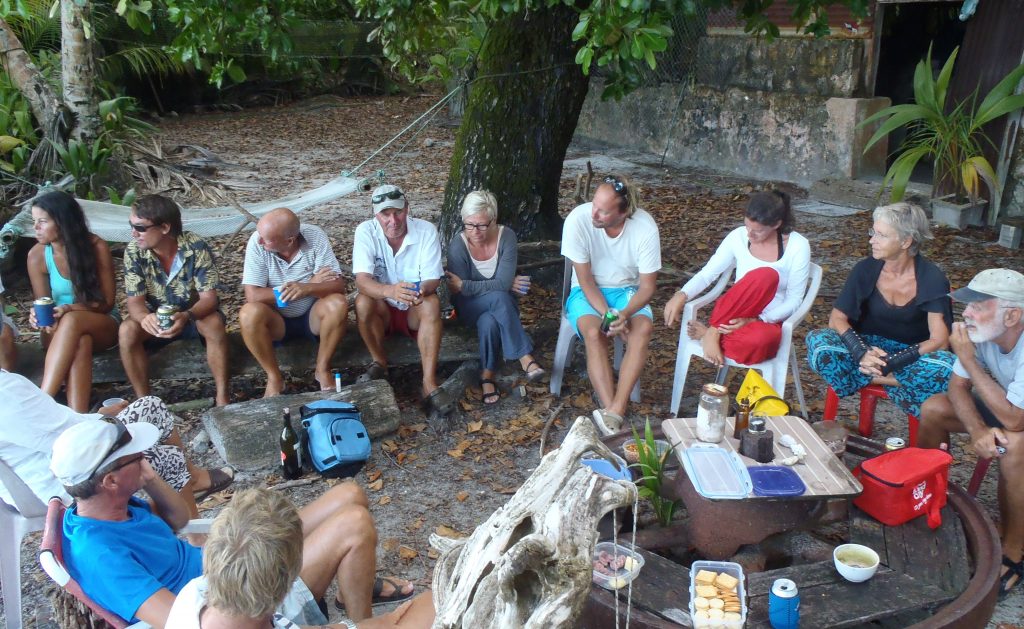
- 2014 – Cruisers gathering at Chagos in the middle of the Indian Ocean
Any other comments:
Over the past eight years, we have met many like-minded sailors and made friends from many countries. There are literally thousands of people sailing around the world – a world and lifestyle which we knew little about in 2010.
The cruising community is made up of all sorts of people with interesting careers – along the way we’ve met a British potato farmer in the Caribbean, a Swedish corporate lawyer in Cuba, a Scottish newspaper editor in Sri Lanka, and in Darwin we met a women’s clothing store owner from Finland. The common link – we are all cruisers.
It’s really a wonderful lifestyle and we are truly blessed to be able to sail the world aboard our little Blue Heeler.
…………………………………………………………………………………………………………………………………..
The opinions expressed in this article are the author’s own and do not reflect the view of Noonsite.com or World Cruising Club.
Related to following destinations: Australia
Related to the following Cruising Resources: Portrait of a Cruiser



